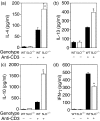Increased interleukin-10 production and Th2 skewing in the absence of 5-lipoxygenase
- PMID: 17894798
- PMCID: PMC2433306
- DOI: 10.1111/j.1365-2567.2007.02694.x
Increased interleukin-10 production and Th2 skewing in the absence of 5-lipoxygenase
Abstract
Eicosanoids (prostaglandins and leukotrienes) are important mediators of inflammatory responses. These lipid mediators may also regulate the production of peptide mediators of the immune system. In this study, we investigated the effect of the absence of 5-lipoxygenase (5-LO)-derived leukotrienes on interleukin (IL)-10 production. IL-10 is a key regulator of immune and inflammatory responses, and previous studies have suggested that prostaglandins effect their immunosuppressive functions in part by stimulation of IL-10 production. We therefore investigated whether leukotriene production would have a similar role in regulation of IL-10 production. We have made the striking observation that absence of 5-LO-derived leukotrienes results in increased IL-10 production with a concomitant decrease in the production of pro-inflammatory cytokines, including tumour necrosis factor (TNF)-alpha and IL-12. Moreover, T-cell cytokine production in the absence of 5-LO-derived leukotrienes results in increased IL-4 production and decreased interferon (IFN)-gamma production. This may be in part secondary to increased IL-10 production and its effects on dendritic cell function resulting in altered T-cell differentiation. These findings indicate that, in addition to the central role leukotrienes play in the acute inflammatory response, endogenous leukotrienes are also important regulators of inflammatory cytokine production, via regulation of IL-10 production and in vivo differentiation of T cells.
Figures









Similar articles
-
5-Lipoxygenase negatively regulates Th1 response during Brucella abortus infection in mice.Infect Immun. 2015 Mar;83(3):1210-6. doi: 10.1128/IAI.02592-14. Epub 2015 Jan 12. Infect Immun. 2015. PMID: 25583526 Free PMC article.
-
Intravenous anesthetic propofol suppresses leukotriene production in murine dendritic cells.J Immunotoxicol. 2013 Jul-Sep;10(3):262-9. doi: 10.3109/1547691X.2012.712066. Epub 2012 Sep 7. J Immunotoxicol. 2013. PMID: 22953970
-
5-Lipoxygenase-derived lipid mediators are not required for the development of NSAID-induced inflammatory bowel disease in IL-10-/- mice.Am J Physiol Gastrointest Liver Physiol. 2008 Feb;294(2):G477-88. doi: 10.1152/ajpgi.00229.2007. Epub 2007 Nov 29. Am J Physiol Gastrointest Liver Physiol. 2008. PMID: 18048478
-
Immune-regulation and -functions of eicosanoid lipid mediators.Biol Chem. 2017 Oct 26;398(11):1177-1191. doi: 10.1515/hsz-2017-0146. Biol Chem. 2017. PMID: 28622139 Review.
-
Role of lipid mediators and control of lymphocyte responses in type 2 immunopathology.J Allergy Clin Immunol. 2018 Apr;141(4):1182-1190. doi: 10.1016/j.jaci.2018.02.006. Epub 2018 Mar 2. J Allergy Clin Immunol. 2018. PMID: 29477727 Review.
Cited by
-
Montelukast, a cysteinyl leukotriene receptor-1 antagonist protects against hippocampal injury induced by transient global cerebral ischemia and reperfusion in rats.Neurochem Res. 2015 Jan;40(1):139-50. doi: 10.1007/s11064-014-1478-9. Epub 2014 Nov 18. Neurochem Res. 2015. PMID: 25403620
-
Differences in cNOS/iNOS Activity during Resistance to Trypanosoma cruzi Infection in 5-Lipoxygenase Knockout Mice.Mediators Inflamm. 2019 Oct 24;2019:5091630. doi: 10.1155/2019/5091630. eCollection 2019. Mediators Inflamm. 2019. PMID: 31772504 Free PMC article.
-
Protective Effects of Quercetin on Livers from Mice Exposed to Long-Term Cigarette Smoke.Biomed Res Int. 2020 Nov 15;2020:2196207. doi: 10.1155/2020/2196207. eCollection 2020. Biomed Res Int. 2020. PMID: 33282940 Free PMC article.
-
Polyunsaturated Fatty Acid-derived lipid mediators and T cell function.Front Immunol. 2014 Feb 25;5:75. doi: 10.3389/fimmu.2014.00075. eCollection 2014. Front Immunol. 2014. PMID: 24611066 Free PMC article. Review.
-
Selective inhibition of IFNG-induced autophagy by Mir155- and Mir31-responsive WNT5A and SHH signaling.Autophagy. 2014 Feb;10(2):311-30. doi: 10.4161/auto.27225. Epub 2013 Dec 10. Autophagy. 2014. PMID: 24343269 Free PMC article.
References
-
- Capra V, Thompson MD, Sala A, Cole DE, Folco G, Rovati GE. Cysteinyl-leukotrienes and their receptors in asthma and other inflammatory diseases: Critical update and emerging trends. Med Res Rev. 2007;27:469–527. - PubMed
-
- Fretland DJ, Djuric SW, Gaginella TS. Eicosanoids and inflammatory bowel disease: regulation and prospects for therapy. Prostaglandins Leukot Essent Fatty Acids. 1990;41:215–33. - PubMed
-
- Ford-Hutchinson AW, Gresser M, Young RN. 5-Lipoxygenase. Annu Rev Biochem. 1994;63:383–417. - PubMed
-
- Murakami M, Penrose JF, Urade Y, Austen KF, Arm JP. Interleukin 4 suppresses c-kit ligand-induced expression of cytosolic phospholipase A2 and prostaglandin endoperoxide synthase 2 and their roles in separate pathways of eicosanoid synthesis in mouse bone marrow-derived mast cells. Proc Natl Acad Sci USA. 1995;92:6107–11. - PMC - PubMed
Publication types
MeSH terms
Substances
Grants and funding
LinkOut - more resources
Full Text Sources
Molecular Biology Databases

